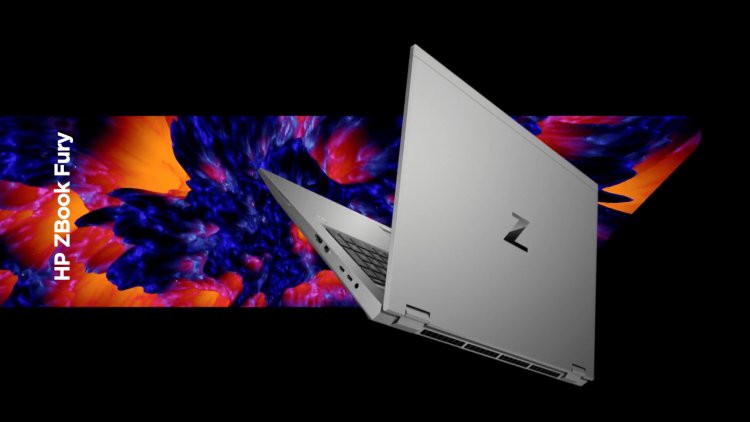HP ZBook Fury 17 G7: Rock solid

Introduction, design
The HP ZBook Fury G7 knows exactly what it wants to be: a portable workstation, nothing more, nothing less.
External
While HP notebooks are not without form-breaking, eye-catching designs, the business is known for conservatism rather than inventiveness. This is especially true with the G7, which fully embodies the "square tray" design language. Its only decoration is a large, chrome-plated Z on the cover - perhaps a touch larger than necessary; a smaller, thinner-lined mark might complement the machine's style (and the company's current emblem below the display).
We have no complaints about the assembly or material selection; the machine casing is solid, does not crack or twist, has no connection gaps, and you do not even know the values stated in the MIL-STD-810H standard on paper. Of course, everything comes with mobility: the ZBook Fury 17 weighs 2.91 kg and measures 399 x 267 x 27 mm, so it doesn't even try to be light or small.
The screen is held in place by two huge hinges with multiple pivot points, and their weighting is well-balanced. The screen can be opened and moved with one hand, and it can be folded back 180 degrees if necessary. The frame's thickness is typical for today's eyes, the webcam with a physical lock fits comfortably at the top, and the previously stated HP logo sits at the bottom.
The Bang & Olufsen speakers are hidden behind the tiny grille above the keyboard at the bottom, and there's enough room for our wrists as well. At the bottom, we discover a cover that is quite simple to remove: after sliding the latch in the center, this plate may be slid and removed. This allows you to easily extend the key components, such as memory and storage, as well as remove the battery by releasing two latches if you need to replace them.
On the hefty sides of the laptop, there's a SmartCard reader, a combined audio connector, three USB 3.1 Gen1 (Type-A) connectors, a Gigabit Ethernet port on the left, and an SD card reader, HDMI, mini DisplayPort, and two Thunderbolt ports on the right 3 (Type-C).
Hardware and performance
The processors used in the ZBook Fury 17 G7 range from the Intel Core i3-10300H to the Core i9-10885H and Xeon W-10885M. The device we examined is a high-end variant with a Core i7-10750H processor and 16GB of RAM (maximum supported without 128GB ECC and 64GB ECC). You can mostly choose Quadro GPUs based on category - the test system has a Quadro T1000 Max-Q, which is a little outdated today because it is based on the Turing architecture.
It is based on the TU117, which also works on the GTX 1650, but this time with a base frequency of 765 MHz and a boost clock of 1150 MHz.
There's lots of storage variety since you can install three M.2 drives or a 2.5 "disk instead of one (which uses half the battery, so it's best to stick with the SSD, though HP also provides HDDs).
name of Product HP ZBook Fury 17 G7 Processor Intel Core i7-10750H - 2.6 / 5.0 GHz, 45 W TDP Memory 1 x 16 GB (SK Hynix) DDR4-3200 Display 17 "1920x1080 pixel BOE BOE08D3 IPS panel with 16: 9 aspect ratio with automatic brightness adjustment Graphics - Intel UHD Graphics 630
- NVIDIA Quadro T1000 Max-Q 4 GB GDDR5Data storage 512 GB Toshiba / Kioxia SSD, PCIe 3.0 x4 Optical drive no Communication - Intel Wi-Fi 6 AX201
- Bluetooth 5.0
- Intel I219-V Ethernet (1GBASE-T)Interfaces - 2 Thunderbolt 3 (Type-C)
- 3 USB 3.1 Gen1 Type-A (one can charge)
- 1 HDMI
- 1 mini DisplayPort
- 1 Gigabit Ethernet
- 1 combined 3.5 mm audio connectorExtras keyboard backlight, fingerprint reader, SD card reader, SmartCard reader, IR camera for face recognition Battery 94 Wh Size 399 x 267 x 27 mm Crowd 2.91 kg Operating System Windows 10 Pro
Performance
The Kioxia (Toshiba) SSD is definitely in the mid-range, with 512GB of space and performance, and a workstation would be better suited to a drive with at least 1TB. Regardless, its speed is adequate, and it is not intended to stifle the other components.
In terms of general - and not just multimedia and professional - use, the results are adequate, but not remarkable. When compared to the Acer Nitro 5, which is also equipped with the Core i7-10750H but tuned for gaming, we can see that the ZBook Fury is not a slouch in terms of CPU-centric measurements, but where the GPU plays a more important role, the Quadro based on Turing certainly lags behind the RTX 3060 (Ampere), even if it is not a game.
Measurement Result 7-Zip Single / Multi 5467/33 725 MIPS Cinebench R15 OpenGL / CPU 176.98 fps / 1258 cb Cinebench R20 CPU Single / CPU Multi 501/2787 cb Cinebench R23 CPU Single / CPU Multi 1285/6880 cb Veracrypt64 SHA 256 / SHA 512 332/479 MB / s PCMark 10 Extended 5434 PCMark 10 Essentials / Productivity 9120/7461 PCMark 10 Digital Content Creation / Gaming 5561/6229 PCMark 10 Office 2016 10 527 Procyon Photo Editing / Video Editing 5761/3141 SpecWPC 7-Zip Compress * 224.6 s SpecWPC Blender BMW 1M * 109.3 s SpecWPC Handbrake Normal / HQ 59.46 / 22.76 fps SpecWPC Maya Shaded Wire 36.4 fps SpecWPC Python SciPy * 112.97 s
The notebook operates virtually silently without load, but it is sufficient to use it sparingly, and its fans have already switched to a greater speed, implying a hissing sound, if not excessively disturbing. When the load is processor-centric, the CPU consumption increases to 85 watts for around 15 seconds before returning to the 45 watts mentioned in the specs. This is accompanied by a brief temperature surge of 94 ° C, after which the temperature stabilizes around 66 ° C. This is an excellent value, but perhaps it would be preferable to get quieter cooling in exchange for, perhaps, +10 ° C.
Evaluation
The HP ZBook Fury 17 G7 offers a lot of outstanding characteristics when viewed as a portable workstation, but it has a slight flaw: the following model is currently available in stores, with 11th generation processors and improved graphics. Of course, whether it's worth waiting for the G8 is heavily dependent on availability and pricing, which is very volatile in this situation. However, because this notebook is not primarily sold by the manufacturer in the consumer market, the price is almost always unique and can include many manufacturer services in addition to hardware, such as a 4-5 year warranty, next business day on-site disembarkation, and troubleshooting, accident protection, and so on.
What we can't expand on is the screen, and this 17-inch display is too "average" for the ZBook Fury's capabilities (and price) and is better suited for tasks where color accuracy isn't critical (multimedia). Although neither is extremely high resolution (CAD / CAE, etc.) required, the ordinary ZBook user is likely to benefit from one of the 4K screens.
Aside from that, the fundamentals are perfect: the engine room is not only scalable, but also difficult to create, the connection range is extensive, and the cooling system is outstanding. In terms of extras, the manufacturer's support, a quick fingerprint reader, and a webcam with facial recognition are only the beginning.





























